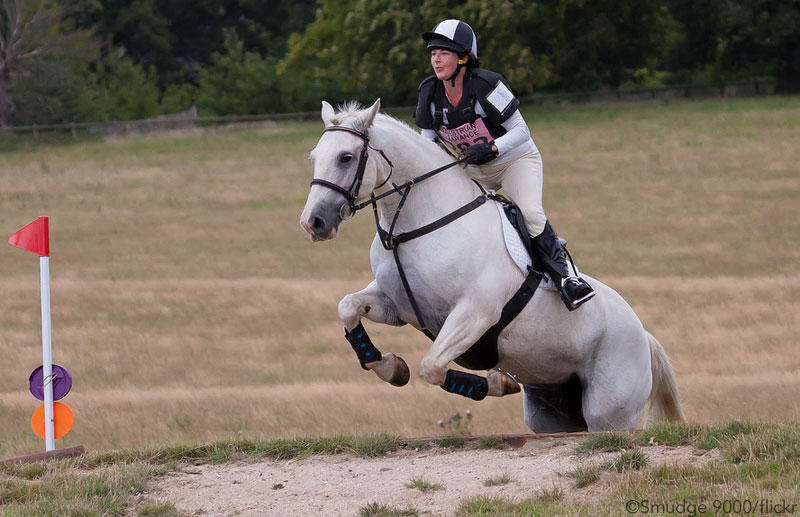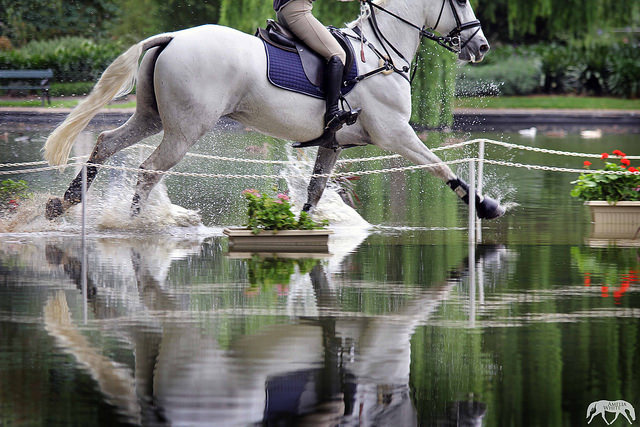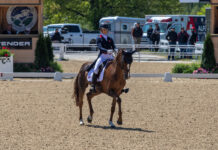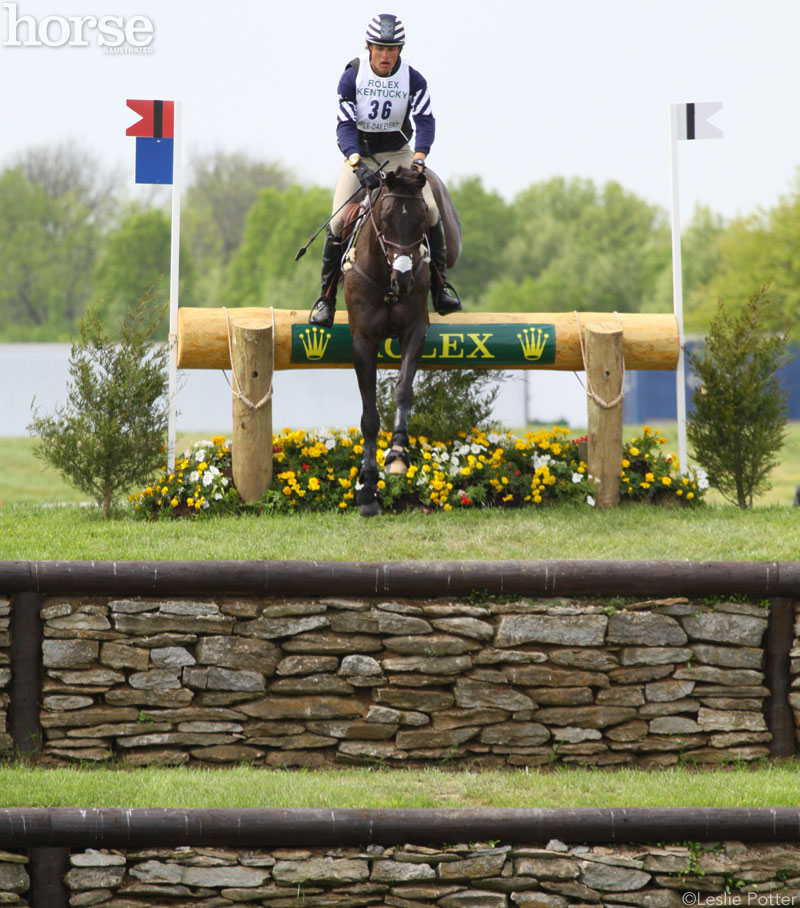
Boyd Martin and Remington XXV jump into The Hollow at the 2010 Rolex Kentucky Three-Day Event.
Few things compare to the thrill of galloping around a cross-country course on a well-schooled horse. Introducing your horse to the challenges of cross-country in a safe and confidence-building way will guarantee that you’ll both have fun in the future, rather than fighting fears. Once your horse is comfortable jumping straightforward obstacles, you’ll want to introduce him to the three types of fences that set cross-country jumping apart: ditches, banks and water.
Get Started in the Arena
“Before I even consider cross-country schooling my young horses, there are a number of things I want to achieve in their training,” says Martin. “It’s pointless going cross-country schooling with a horse that doesn’t have any jumping experience under his belt.”
Start out in the arena so your horse can learn the fundamentals of jumping. Martin feels that it’s always best to start your horse’s jumping education in a ring with good footing and straightforward jumps, so you can give him an understanding of getting from one side of a jump to the other in an organized fashion.
“A foxhunter will learn to jump out in the field, and so will a steeplechaser, but for an eventer I think it’s smart to get started in the arena since we have to do the show jumping in there too,” says Martin.
He likes to give the horse a couple months to learn the basics before trotting and cantering banks, but says there’s no set rule for how much experience is necessary.
“Look for a feeling of confidence, where he’s almost bored jumping at home, before you start [with cross-country],” says Martin. “If things are scary or not established in the ring, chances are it’s probably only going to get worse when you go cross-country schooling.”
The horse should also be capable of riding outside of the arena through the countryside without jumping before you start schooling cross-country fences. “Trail riding, flatwork in a field, a hack in the woods—all of this will help your horse understand the idea of going out in the open before he faces fences on uneven terrain,” says Martin. He and his wife spend a lot of time foxhunting every November and December after the competition season in the Northeast wraps up before heading to their winter base in Aiken, S.C.
Small, Simple Obstacles
Before you run out and start jumping any old cross-country jump at random, Martin says your introductory jump selection is critical. They key to a successful beginning is keeping things tremendously easy so that the horse builds confidence one step at a time.
“These introductory jumps have to be [a size] that the horse can walk over,” he says. “The bank needs to be an up-bank, because it is less daunting for the horse to step up a bank. The ditch can’t be super-wide; it should be something he can step over or hop from a standstill. Then the horse can potentially come up to the edge of the ditch, stop and look at it, and then step over rather than turning and re-presenting to the jump. If you turn away from any obstacle too many times, the horse gets the idea he can turn around before he re-tries something. The dimensions should be such that he can dance around a bit and then step over without being re-presented.”
Rider Position
The simplest advice Martin gives people for adjusting their position in cross-country versus show jumping is that things basically stay the same, except you should lengthen your reins about 2 inches, which allows your position to come just slightly behind the motion without pulling on the horse’s mouth. Then if he stumbles or hesitates, it allows your body to come back into the saddle more easily and be in a slightly defensive position.
Setting Goals
For less experienced horses and riders, Boyd notes that it’s important to be schooling above the level you plan to compete at to ensure a confident outing.
“There’s no specific timeline I use, but the first couple of cross-country schools will be a real learning process for your horse,” says Martin. “I’d let him see a few different schooling courses before I take him to his first event. You’ll get a different feeling from your horse, and the courses will have a completely different look when you get to an event because of all of the activity on the grounds as well as the flags and decorations on the jumps.”
Cross-Country Obstacle No. 1: Banks
Martin finds banks one of the easier types of jumps for young horses to understand, so he recommends starting with them. “My mentor, Phillip Dutton, always taught me you’re better teaching a horse that is new to banks to go up rather than down them,” he says. “In my experience, I also find horses are more encouraged about going up something than jumping down. You can go up a small bank from a walk, and the walk is a good place to start because the horse’s adrenaline levels are low, he’s thinking slowly, and he reads the question better. For the rider, it’s also easier to stay with the horse at the walk; there’s less chance of the horse scooting out from under you.”
Martin suggests finding a bank complex with a ramp leading up to the top of the bank as another good place to start. Walk up and down the ramp first, then hop up the bank and walk down the ramp quietly and calmly. Finally, walk up the ramp and drop down the bank, keeping the horse relaxed and the situation low-pressure, rather than demanding that your horse be brave and jump off the bank right away.
“When you’re walking off a bank, the horse should learn to ‘dribble off’ the edge, or step down and land close to the base of the fence rather than leaping out into space, which often results in an uncomfortable, back-footed landing that is also hard to sit,” says Martin. “When the horse knows he can just sort of slither off a little bank, it’ll come in handy later. When you’re going into a sunken road or a big pit, you really don’t want your horse to leap off the bank because you need room to negotiate the next part of the combination.”
Cross-Country Obstacle No. 2: Water
When you look at the surface of a body of water—whether it’s a puddle, a swimming pool or a lake—it’s impossible to tell its depth. From a young horse’s point of view, when he sees a water jump, his concern is whether it’s 2 inches deep or 20 feet deep. They need to learn that every time they enter water, it’s only a couple inches deep. It’s especially important when you school a young horse that you stick to a reliable schooling jump that has a consistent depth of water and reliably safe, consistent footing.
With a young horse, it’s always helpful if you can pair up with a more experienced horse. Watching his friend jump various obstacles with ease creates a lot of self confidence in both the horse and the rider that it can be done.
“Walking and trotting through the water will introduce the horse slowly,” says Martin. “If you can find different entry points to go in and out of the water, it helps horses build confidence about going from dry ground into the water. Once they’re in the water, they’re usually quite happy. Let them paw and splash around and have fun with it—but obviously if they look like they want to roll, give them a good cluck and keep their head up!”
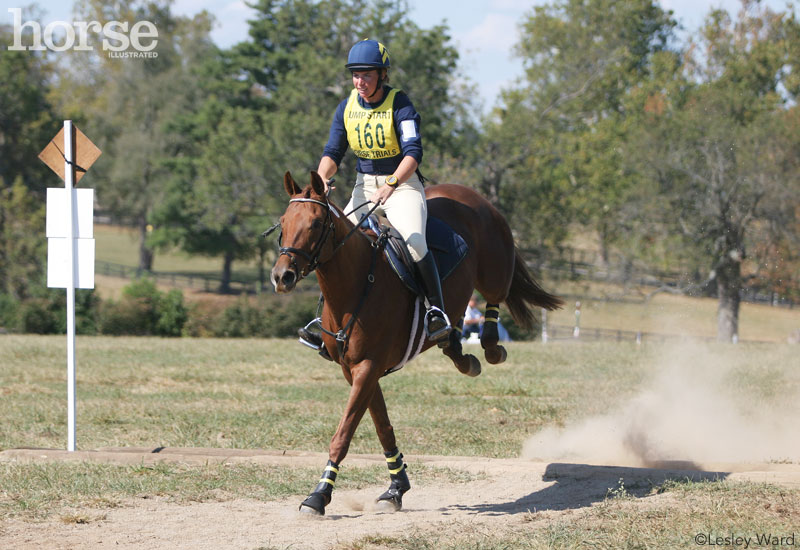
Cross-Country Obstacle No. 3: Ditches
Ditches are similar to water in that the horse has to get an idea of what it is he’s supposed to do. The smaller the ditch, the easier it is for the horse to learn he can just hop from one side to the other.
“Some horses find this easy, while some find it a bit traumatic,” says Martin. “If the horse starts out nervous, he might just jump the ditch and find it’s a piece of cake, so a lot of repetition is key, sticking to narrow, shallow ditches to build confidence. ‘Shallow’ is the key so if the horse steps into the ditch he can easily step out, not sink up to his hock and get scared or feel trapped.”
Ditches require a different approach from banks and water when starting out. You can let your horse look at the ditch without presenting it by walking him parallel to it in both directions so he can look at it with each eye. Once he does this calmly, you’re ready to present him to it and pop over it.
“I’d approach the ditch for the first time in a trot,” says Martin. “If you’re good with your leg, a well-timed cluck or spur can nudge the horse over if he hesitates at the last moment. Then each time you come again, use less driving aid so the horse is really jumping it on his own.”
Your position can be back behind the motion with a bit longer rein so you don’t catch the horse in the mouth. If anything goes wrong, you’re likely to fall forward, so sitting back in a defensive position will help avoid that. It’s OK to be left behind over the ditch, since the horse is jumping across it rather than over it.
Creating Confidence
You may be tempted to try increasingly difficult challenges, like jumping a log into the water, but Martin cautions that it’s better to take things slowly with your young horse. “You’re always better off leaving a cross-country school thinking, ‘I could have done a bit more,’ rather than, ‘Gee, I wish I hadn’t tried that last jump because it was too much and did more harm than good,’” says Martin.
“Stick to jumps that are almost too easy, because that creates confidence. Even if you have to drive a ways to the nearest schooling course, or pay a fee every time you school, it’s worth it in the long run to do a few separate schooling sessions that feel easy, rather than one school where you try to jump every jump on the course and shatter the horse’s confidence.”
Expanding your young horse’s repertoire to include ditches, banks and water will make schooling cross-country a lot more fun and exciting. All of these obstacles are essential to master before your horse’s first event. Just make sure to take your time, keep the fences small, and keep the schooling positive so that your horse stays confident. Mastering these first small steps can lead to much bigger things in your horse’s future.
Lifelong horsewoman AMBER HEINTZBERGER is a freelance writer and photographer whose work has appeared internationally. Her latest book is Modern Eventing with Phillip Dutton, and she is co-author of the 2008 American Horse Publications book of the year Beyond the Track.
This article originally appeared in the November 2014 issue of Horse Illustrated magazine. Click here to subscribe!

